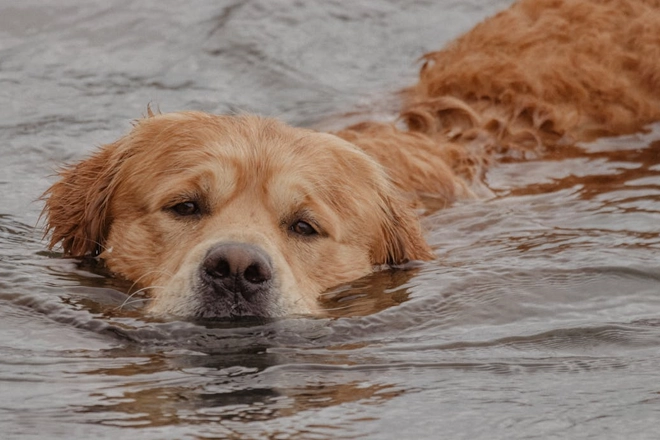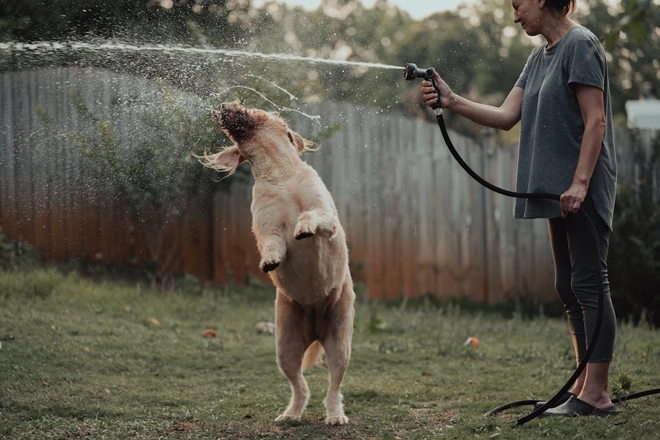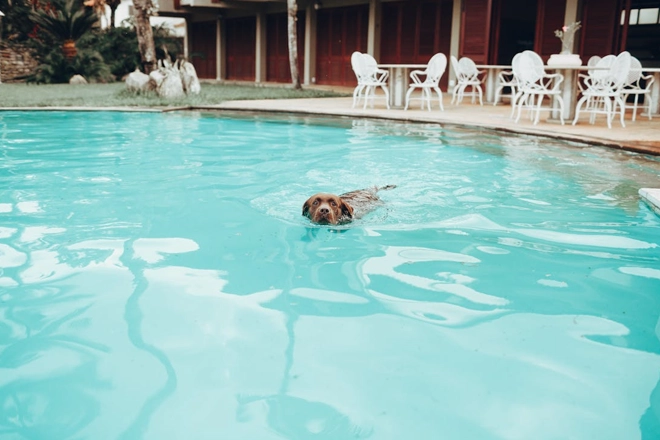For the Purrbabies


If your dog loves splashing, swimming, or lounging in the water, these activities will keep them cool and engaged all year round.

Summertime (or any time, really) can be a great time for your dog to get out, active, and in the water. While not all dogs like being around or in bodies of water, you should know how to best take care of your dog if they do. From activities at home or away, we’re exploring some fun ways to get in the water.
You don’t have to travel far to have fun in the water. In fact, you can do it right from the comfort of your home (or backyard, preferably).
While we love adventuring, it isn’t always feasible. But the next best thing is right at home. Accessible and familiar, it only takes a bit of imagination to spruce things up and turn your backyard into your dog’s own personal waterpark.

Water loving dogs would love even a tub of water, but a pool gives them extra space to play and swim around. If you don’t have a pool, consider asking a friend to use theirs or research pet-friendly pools in the area.

You’ll want to be careful of chemicals. Most pools are chlorinated, meaning that the chemical chlorine is used to disinfect and kill viruses and bacteria. Because of that, pool water should not be ingested by your dog, nor should it sit on their skin for too long in case of irritation.
"Thankfully the levels of chlorine typically used in human swimming pools are very safe for dogs as well! A quick rinse with water after getting out of the pool is sufficient and regular baths are recommended if your pup swims often. While dogs can safely drink a few sips of pool water from both chlorine and salt water pools, if they drink an excessive amount this could cause issues such as vomiting and diarrhea." -Jennifer Schott DVM
👉If you live in an apartment, you’ll want to confirm with management about whether dogs are allowed in pools or not. Often these pools will have doggie hours or doggie swim sessions towards the end of the season ahead of closing.
🚨Make sure your dog is wearing a life vest if they’re not a proficient swimmer.
If you’re heading outdoors, water-loving dogs can join in on the fun—just make sure you prep ahead of time. After all, lots of unpredictable things can happen in an uncontrolled environment such as the ocean or a lake. So before you head out, be sure you know where you’re going and what you’ll be doing so you can pack appropriately and be ready for whatever the day may throw at you.
Cool freshwater spots are ideal for active dogs, and there are plenty of great spots on the shores of lakes and rivers to access. Look for calm areas with shallow banks for easy entry and exit, but avoid areas with fast currents, steep drop-offs, and stagnant water, which can harbor bacteria or parasites.
You’ll also need to be on the lookout for other dangers such as broken glass or other sharp trash, blue-green algae, or wildlife like snakes or bears. Since you won’t be at home, you’ll also need to make sure you have enough water for your dog as well as food and a flotation device for your dog.
Once you’re prepped and ready, there are a ton of fun activities to get into like:

If your local beach allows dogs, it can be paradise. There’s simply nothing like sand between your toes (and paws) and the salt air blowing in your face. Just be sure to check for leash laws and other regulations about pets. Once you’re in the clear there, bring shade, fresh water, and pet-safe sunscreen if your dog has an especially short coat (or if they’re hairless).

🚨Do not allow your dog to consume salt water. If your dog does and they start showing adverse reactions, get them to a vet immediately.
Some parks and beaches have designated dog swim areas while others might be off-limits to pets. It’s your job to do the research ahead of time to know the rules and regulations of the area you’re headed to, as well as the conditions of the body of water you’ll be swimming in.
Brackish water can harbor dangerous bacteria which can cause severe infections in both dogs and people. Not to mention that after storms or heavy rainfall, runoff can pollute rivers, lakes, and even beaches—making them unsafe for swimming. In some areas, harmful algal blooms can be toxic if ingested or even touched.
Check with local authorities or park services for posted advisories, and look up recent news reports or health department updates about the region. Apps and websites like Swim Guide or local environmental agencies often provide real-time updates on water conditions.
Some dogs don’t just enjoy the water—they’re built to work in it. These breeds have the instincts to perform essential tasks in the water that go beyond play.
Organizations like the AKC recognize water-based search and rescue work as a specialized skill. Breeds like Newfoundlands, Golden Retrievers, and Labrador Retrievers are often trained to assist in water rescues, being able to pull people or gear to safety. These dogs undergo rigorous training and are vital team members in situations like natural disasters, drownings, or remote rescues that boats can’t reach. Their swimming ability and loyalty make them ideal for lifesaving work.
If your dog is a natural swimmer with lots of energy, aquatic sports are a great way to challenge their body and mind. Sports like dock diving and retrieving competitions tap into their instincts while offering fun, structured activities. Some pups even compete in surfing contests or water rescue trials that showcase their training. These sports aren’t just great exercise, they also build confidence, discipline, and deepen your bond.
Some dogs are naturally drawn to the water and may even thrive when given the opportunity to swim, work, or play in it. Others may prefer to stay dry and inside. If you're still deciding on the right breed for your lifestyle, it’s worth considering how important water activities are to you, and whether a water-loving dog fits into that. Understanding your future pup’s instincts can help you set them up for a life full of safe, joyful enrichment.
👉Not sure which dogs love the water most? Check out our guide to dog breeds that love water.








